

Kidlink Global Education Projects. Global Education. Five-Minute Film Festival: Developing Global Citizens. In our increasingly connected and interdependent world, it’s critically important that young people have opportunities to engage with diverse cultural perspectives, build geographic knowledge, grow global competency, and develop the skills and knowledge necessary to consider and address our shared global challenges.

At Global Education Day in Atlanta this year, I was inspired by all the ways that educators are bringing these kinds of experiences into the classroom. How do you teach global citizenship? Check out this video playlist for ideas and inspiration. Video Playlist: Developing Global Citizens Watch the player below to see the whole playlist, or view it on YouTube. Planetary Collective Presents CONTINUUM [Trailer] (3:16) Poets, astronauts, storytellers, and others discuss our shared planetary destiny; in tandem with OVERVIEW, an earlier film about astronauts’ stories of seeing the Earth from space, this clip may help spark conversations about global stewardship.
Connected Classrooms Workshop – Communauté – Google+ Flat Connections - Transforming learning through global collaboration. 0132610353.pdf. Teachers, open up your classrooms! Collaborative Communities: Developing Children as Global Citizens Education is the most powerful weapon which you can use to change the world.
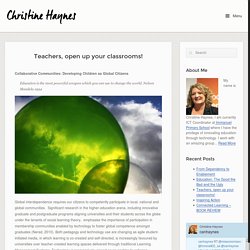
Nelson Mandela 1994 Global interdependence requires our citizens to competently participate in local, national and global communities. Significant research in the higher-education arena, including innovative graduate and postgraduate programs aligning universities and their students across the globe under the tenants of social learning theory, emphasise the importance of participation in membership communities enabled by technology to foster global competence amongst graduates (Nerad, 2010). Both pedagogy and technology use are changing as agile student-initiated media, in which learning is co-created and self-directed, is increasingly favoured by universities over teacher-created learning spaces delivered through traditional Learning Management Systems.
We can no longer prepare our students for a world of the past. Image: CC by Keoni Cabral. Four Steps for Jumpstarting Global-Collaboration Projects - Education Week Teacher. Annenberg Learner - Teacher Professional Development. Projects. Curricula. Global Virtual Classroom: A Free Online Educational Program. Voicethread 4 Education - Classroom Partners. Online Student Collaboration. Collaboration Projects. Online Collaboration Projects Are you looking for creative ways to engage today’s learners while ensuring your lessons meet both curriculum and technology standards?
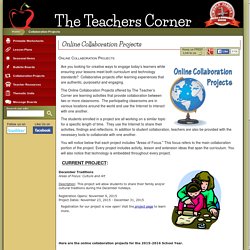
Collaborative projects offer learning experiences that are authentic, purposeful and engaging. The Online Collaboration Projects offered by The Teacher’s Corner are learning activities that provide collaboration between two or more classrooms. The participating classrooms are in various locations around the world and use the Internet to interact with one another. The students enrolled in a project are all working on a similar topic for a specific length of time.
You will notice below that each project includes "Areas of Focus. " Online Collaborative Projects. Online Collaborative Projects What's it like to be an astronaut?
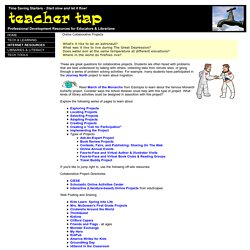
What was it like to live during The Great Depression? Does water boil at the same temperature at different elevations? Where in the world do fireflies live? These are great questions for collaborative projects. Read March of the Monarchs from Edutopia to learn about the famous Monarch butterfly project.
Explore the following series of pages to learn about. Global SchoolNet: Find Partners or Projects. Global Collaboration Projects that Go Way Beyond Skype. Collaboration & Social Networking | Feature Global Collaboration Projects that Go Way Beyond Skype Here's how one program is engaging Web 2.0 skills to bridge cultures and classrooms — one project at a time.

The world is flat, author and New York Times columnist Thomas Friedman once declared in a bestselling book about the rise of global communications. If Julie Lindsay had anything to say about it, the classroom would also be flat. Lindsay, an online teacher and former IT director for international schools from Queensland, Australia, is the co-founder — and now sole proprietor — of the K-12-focused global outreach organization Flat Connections (formerly known as the Flat Classroom). Lindsay explained that the aim of the flat classroom is to "bring the outside world in and you put your classroom out there.
Flat Connections is not a curriculum per se, but a series of independent collaborative projects. Global Collaboration. What is Global Collaboration?
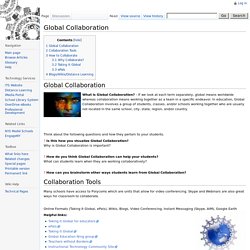
– If we look at each term separately, global means worldwide whereas collaboration means working together as a team in a specific endeavor. In education, Global Collaboration involves a group of students, classes, and/or schools working together who are usually not located in the same school, city, state, region, and/or country. Think about the following questions and how they pertain to your students. Global Education On a Dime: A Low-Cost Way to Connect. Educators don't need huge budgets to develop a global-education program.

One of the best examples of this is a partnership called the Flat Classroom Project that started by connecting an international school in Dhaka, Bangladesh, with an American school in Camilla, Georgia, and has since expanded into many collaborative projects that bring together over 5,000 students in more than 30 countries around the world. The project, based on Thomas L. Friedman's international best seller, The World Is Flat: A Brief History of the Twenty-First Century, calls on American students to partner with students across the globe and conduct a series of activities that deal with globalization.
Here are some ideas to consider based on the experiences of schools that have participated in these sorts of projects: ED Teacher's Guide to International Collaboration on the Internet. As you begin to explore the possibilities for cross-cultural interaction, global classroom projects, and new learning opportunities, the following organizations can assist you in your efforts. ePALS Classroom Exchange - Connects users from around the globe, providing the tools and meeting places to create a worldwide community of learners.
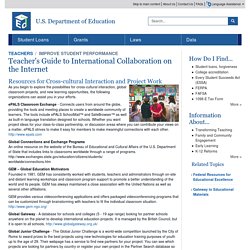
The tools include ePALS SchoolMail™ and SafeBrowser™ as well as built-in language translation designed for schools. Whether you want project ideas for your class-to-class partnership, or discussion areas where you can contribute your views on a matter, ePALS strives to make it easy for members to make meaningful connections with each other. Global Connections and Exchange Programs An online resource on the website of the Bureau of Educational and Cultural Affairs of the U.S. Department of State that includes links to classrooms worldwide through a range of programs. Learning with the world, not just about it ...
Globalcollaborations - home. ePals. Skype in the Classroom - Skype in the Classroom. Empowering teachers to connect, learn, share, collaborate, and lead – globally!